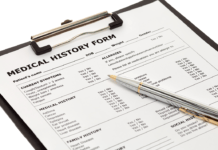Disclosure: This quiz is sponsored content from 3M Oral Care as part of our sponsored partner program.
Test your saliva and xerostomia knowledge with this quick quiz and then discover the prevalence, etiology and impact of xerostomia on today’s population by watching the informative webinar featuring Jo-Anne Jones, RDH!
On average, unstimulated saliva flow rate is 0.3 mL/minute, and the average total for 16 hours (while awake) of unstimulated saliva flow is 300 mL. An unstimulated flow rate below 0.05 mL/minute is considered hypofunction.
“On average, unstimulated flow rate is 0.3 mL/minute, with the average total for 16 hours of unstimulated flow (during waking hours) being 300 mL. Salivary flow during sleep is nearly zero. Unstimulated flow rates below 0.1 mL/minute are considered hypofunction. If individualized base rates of saliva flow have been established, then a 50% reduction in flow should be considered hypofunction.”1
On the other hand, “stimulated flow rate is, at maximum, 7 mL/minute. Stimulated saliva is reported to contribute as much as 80% to 90% of the average daily salivary production. The average daily flow of whole saliva in health is between 1 and 1.5 L.”1
1. Humphrey, S.P., Williamson, R.T. A review of saliva: normal composition, flow, and function. The Journal of Prosthetic Dentistry. 2001; 85(2): 162-169. Retrieved from https://www.thejpd.org/article/S0022-3913(01)54032-9/fulltext
The Challacombe Scale of Clinical Oral Dryness is a scoring system that helps a clinician visually identify and quantify whether a patient has xerostomia.
The Challacombe Scale of Clinical Oral Dryness was developed from research conducted at King’s College London Dental Institute under the supervision of Professor Stephen Challacombe. The purpose of the scale is to be able to visually identify and quantify whether a patient has xerostomia. It works an additive score of 1 to 10, with 1 being the least and 10 being the most severe. There are ten items to look for, which are listed below. Each item scores one point, and depending on how many items are present in the patient determines the severity of their xerostomia.
The items to look for are:
- Mirror sticks to buccal mucosa
- Mirror sticks to tongue
- Frothy saliva
- No saliva pooling in the floor of the mouth
- Tongue shows generalized shortened papillae
- Altered gingival architecture
- Glassy appearance of oral mucosa, especially in the palate
- Tongue lobulated/fissured
- Cervical caries (more than two teeth)
- Debris on palate or sticking to teeth
For each one of the items your patient presents with, a point is given. If a patient has a score of 1 – 3 they can be classified as having mild xerostomia, 4 – 6 is moderate xerostomia, and 7 – 10 is severe xerostomia.
1. Das, P., Challacombe, S.J. Dry mouth and clinical oral dryness scoring systems. Primary Dental Journal. 2016; 5(1): 69-71. Retrieved from https://www.researchgate.net/publication/322009020_Dry_Mouth_and_Clinical_Oral_Dryness_Scoring_Systems
Saliva contains which components?
Saliva is mostly composed of about 99% water. The other 1% or so contains electrolytes (potassium, sodium, magnesium, calcium, chloride, bicarbonate, phosphate, and iodine), antibacterial compounds (i.e., lysozyme), mucus, and the enzyme amylase.1
These components are crucial in order for saliva to aid in remineralization (calcium and phosphate) and maintain a neutral pH (bicarbonate). Other important functions of saliva include1:
- Lubricating and binding masticated food into a slippery bolus, which allows it to pass through the esophagus without causing damage to mucosa.
- Saliva solubilizes food, which allows us to actually taste food.
- Helping clear the mouth of food debris, which aids in removing fermentable carbohydrates (sugars) and acid.
- Initiating of starch digestion by the enzyme amylase, which begins to digest dietary starch into maltose.
- Acting as a primary line of defense. Proteins in saliva act as an antibacterial, antifungal, antivirus and/or antiparasitic substances. A few examples are lysozyme, histatins, lactoferrin, and defensins.
1. Tiwari, M. (2011). Science behind human saliva. J Nat Sci Biol Med. Jan-Jun; 2(1), 53-58. Retrieved from https://www.ncbi.nlm.nih.gov/pmc/articles/PMC3312700/
Xerostomia symptoms can occur even with a normal saliva flow rate.
“Xerostomia is defined as the subjective complaint of dry mouth. Interestingly, patients complaining of xerostomia frequently do not show any objective sign of hyposalivation and their symptoms may be secondary to qualitative and/or quantitative changes in the composition of saliva.”1 In other words, patients may be producing enough saliva; however, the saliva composition is of low quality, so the sensation and consequences of a dry mouth persist.
1. Villa, A., Connell, C.L., Abati, S. Diagnosis and management of xerostomia and hyposalivation. Ther Clin Risk Manag. 2015; 11: 45-51. Retrieved from https://www.ncbi.nlm.nih.gov/pmc/articles/PMC4278738/
Which salivary gland produces the most unstimulated flow of saliva?
“Percentage contributions of the different salivary glands during unstimulated flow are as follows: 20% from parotid, 65% from submandibular, 7% to 8% from sublingual, and less than 10% from numerous minor glands. Stimulated high flow rates drastically change percentage contributions from each gland, with the parotid contributing more than 50% of total salivary secretions.”1
Further, “regional variation in intraoral flow is site-specific, with the mandibular lingual being a site of high volume and the maxillary anteriors and interproximals being sites of low volume flow. These areas of higher and lower volume flow regions have been referred to as ‘salivary highways and byways.’ The regional clearance rate of acid produced from bacteria is directly influenced by regional variations in flow within the mouth. Consequently, salivary byways are areas in which acid by-products may remain in longer contact with oral structures unless mechanical means of cleansing are used.”1
“Moreover, with varying amounts of components and secretions coming from different glands, it is suggested that saliva provides different types of protection in different locations intraorally. For example, parotid saliva contains amylase, proline-rich proteins, and agglutinins with minute amounts of cystatins, lysozymes, and extraparotid glycoproteins. As a result, maxillary premolars exhibit higher counts of salivary agglutinins due to the proximity of the parotid duct. Sublingual saliva contributes high concentrations of both types of mucins, MG1 and MG2, as well as high levels of lysozymes. Submandibular saliva contains the largest amount of cystitis, whereas palatine secretions offer MG1 mucins and relatively high amylase concentrations. Considering that a 0.1-mm-thick layer of saliva on a tooth is thinner than a layer of plaque, it is no surprise that the task of cleansing oral structures cannot be completed successfully by saliva alone.”1
1. Humphrey, S.P., Williamson, R.T. A review of saliva: normal composition, flow, and function. The Journal of Prosthetic Dentistry. 2001; 85(2): 162-169. Retrieved from https://www.thejpd.org/article/S0022-3913(01)54032-9/fulltext
Dental professionals do not need to consider the acidity (pH) of xerostomia relief products when making recommendations to patients.
Dental professionals should consider the acidity (pH) of the xerostomia products they recommend to patients. Not only do bacteria thrive in an acidic environment, but an acidic oral pH can also lead to decalcification, caries, sensitivity, erosion, candidiasis, among other oral diseases.1 “It is imperative that these products help to restore hyposalivation and that they do not present any secondary effect that can harm oral health. It has been shown in the literature that some oral moisturizers may have an erosive potential due to their acidic pH, which is below the critical pH of dentin and enamel.”1 (Note: For products tested showing acidic pH see the link in reference #1 below)
An alternative to aqueous-based xerostomia products, which may have an acidic pH, is 3M™ Xerostomia Relief Spray. This is because it is not an aqueous solution, but a lipid-based solution (Oxidized Glycerol Triesters (OGT technology). Standard pH test methods can only be performed on water-based solutions. Since 3M™ Xerostomia Relief Spray is lipid-based, the pH can’t be measured, but it’s designed to be used in the mouth and safe for its intended use. A systematic Cochrane review found lipid-based OGT technology shows greater effectiveness when compared to water-based electrolyte sprays for xerostomia prevention.2
1. Delgado, A.J., Olafsson, V.G. Acidic oral moisturizers with pH below 6.7 may be harmful to teeth depending on formulation: a short report. Clin Cosmet Investig Dent. 2017; 9: 81-83. Retrieved from https://www.ncbi.nlm.nih.gov/pmc/articles/PMC5546593/
2. Furness, S. Worthington, H.V., Bryan, G., Birchenough, S. McMillan, R. Interventions for the management of dry mouth: topical therapies. Cochrane Database of Systematic Reviews. 2011; 12(CD008934). Retrieved from https://www.cochranelibrary.com/cdsr/doi/10.1002/14651858.CD008934.pub2/full








